Traveling to Barcelona as a solo female traveler? Are you looking to also explore the Costa Brava region?
In this article written by a native Catalan, I will tell you everything you need to know when visiting Barcelona and Costa Brava solo, from travel tips to local customs, from tipping to music, so that you can fit right in and make the most of your time by better understanding Catalans and Catalonia.
Contents
- 1 Brief history of Catalonia and Barcelona
- 2 Quick facts about Catalonia, Barcelona and Costa Brava
- 3 Barcelona and Costa Brava travel tips
- 4 Local cuisine
- 5 Music and bands from Barcelona
- 6 Books about or set in Barcelona and the Costa Brava
- 7 Movies about or set in Barcelona and the Costa Brava
- 8 Shows and documentaries set in Barcelona
Brief history of Catalonia and Barcelona
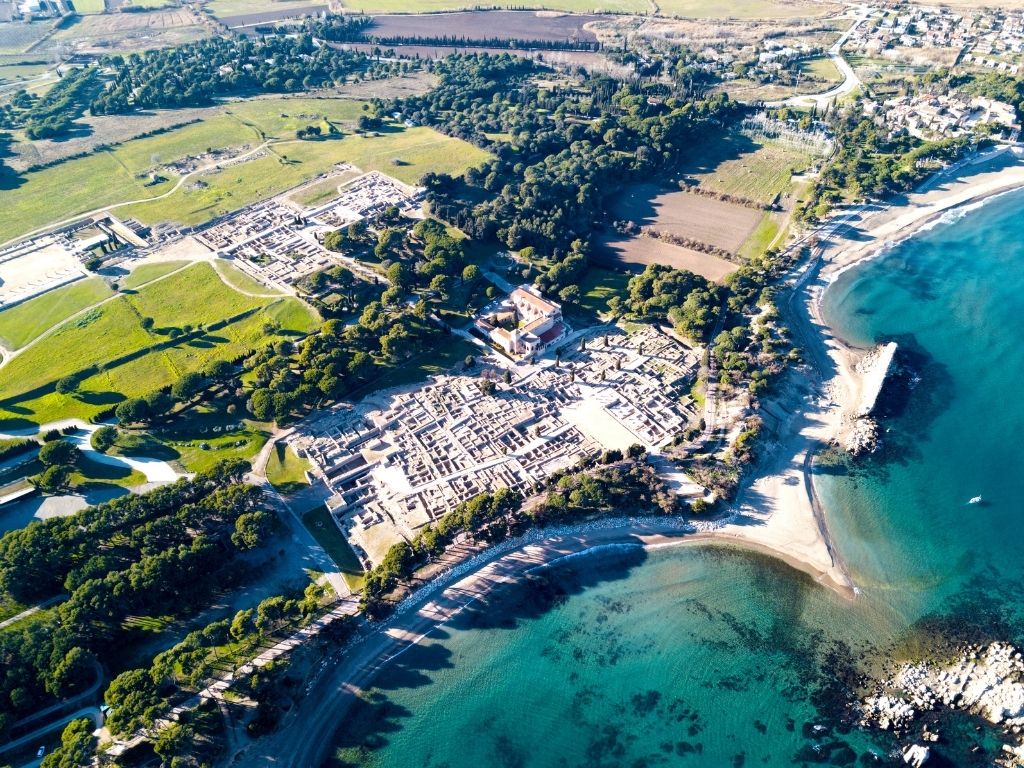
You may have heard that people in Barcelona speak a different language to the rest of Spain, or that we like to party until the wee hours and smear tomato on bread.
Maybe you know that Barcelona was the host of the 1992 Olympics, that it is home to the unfinished Basilica of Sagrada Familia or that more than 50% of the city’s inhabitants were not born there.
Whatever your knowledge of Barcelona is, what you may not be aware of is that the city has stood where it is today for centuries and that, below the current Gothic Quarter lies the ancient Roman city of Barcino that gave it its name.
What makes Barcelona the cosmopolitan, open-minded, diverse and creative city it is today can be explained by its long history and I am going to summarize the city’s history in this section.
Modern Barcelona was founded in the 1st century BC when the Romans built a settlement on the Mediterranean shore between Empuries in the north and Tarraco in the south. They called the colony Barcino and this gave the city its current name.
While most of the former Barcino was destroyed when the city expanded and grew, you can still see remnants of the Roman walls of the city inside private homes and buildings such as the Hotel Mercer, and parts of the Roman Aqueduct were recently discovered and can be seen very near the Cathedral.
Perhaps the most stunning remnants of Barcino are the columns of the Temple of Augustus, founder of the city, which were found during excavations and moved to the entrance hall of the Centre Excursionista de Catalunya for everyone to see.
What is most interesting of Roman Barcino is that, despite the city’s growth and the fact that most of the Roman temples and buildings were not kept, the city’s walls remained as such until Medieval times.
Go up to the top of the belltower of Esglesia del Pi on a guided tour and you can trace the perimeter of Barcino with your eyes, or visit the Barcelona History Museum to see the Roman houses as they once were, kept below the ground at the level of the original Barcino.
With the fall of the Roman Empire, Barcino was taken over by the Visigoth Kings and briefly nominated as its Imperial Seat. With the expansion of the Moors in Spain, Barcelona was held under the rule of the Umayyad Caliphate of Cordoba, but the distance from its center of power in the south left a much smaller imprint on the city as it did in modern day Andalusia.
The Moorish expulsion in the 9th century left Catalonia under the influence of the Carolingian Empire who divided the region into Counties the most important of which was the County of Barcelona, a designation that has been kept until today when the city is referred to as La Ciutat Comtal, the Count’s City.
In Medieval times, Barcelona grew in importance thanks to trade and an important craft industry and became the seat of power of first the Principality of Catalonia in the 11th century, which aggregated all countries under a common set of legislative rules, and then the Corts Catalanes which drafted Catalonia’s first constitution in 1283.
In the 15th century, Les Corts evolved into La Generalitat de Catalunya, today’s government institution, whose seat of power is the Palau de la Generalitat, located in Jaume I Square in the heart of the Gothic Quarter.
In parallel, the city’s walls became too small and started to expand in the 13th century to include adjacent neighborhoods that had sprung outside the main Roman walls such as La Rambla, or La Ribera.
The later part of the Middle Ages gave rise to a construction boom in the traditional Catalan Gothic style that can still be seen across the Gothic Quarter, from Santa Maria del mar Cathedral to the many palaces and mansions.
Until the end of the 15th century, Barcelona remained the seat of the Crown of Aragon but when King Ferdinand married Queen Isabel of Castille and both Crowns merged, the government was moved to Castille and Barcelona’s importance started to decline.
The discovery of America continued to push trade towards the New World and away from the Mediterranean where Barcelona had thrived and tensions with the central government continued for the next century.
Finally, in 1714, during the War of Spanish Succession, Catalonia sided with Archduke Charles III of Austria instead of the Bourbon lineage that has remained in power in Spain until today and which was favored by Castille.
When the Archduke lost, Philip the V came to power with an absolute Monarchy that abolished all Catalan institutions, including La Generalitat, banned the Catalan language and knocked down the entire neighborhood of La Ribera to build a Ciutadella, or military citadel, to control and terrorise in the inhabitants of Barcelona.
Despite the controls and the oppression from the central government, Catalonia continued to prosper and develop thanks to a growing draft and trade industry, the construction of the new port and a nascent but expanding textile industry that brought industrialization and attracted a global workforce.
Steam power used in factories propelled the city’s growth and the medieval walls were finally demolished and a new neighborhood called Eixample imagined by Ildefons Cerda.
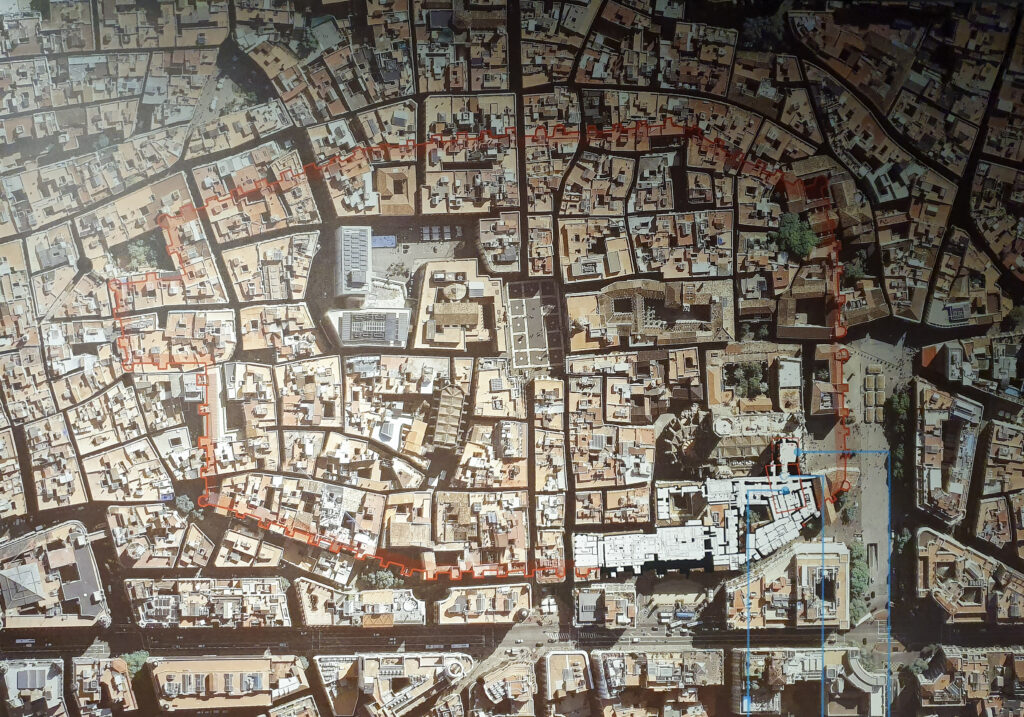
The citadel was demolished to host the 1888 World trade Fair and was then turned into a park that still stands today, and the Eixample district gave way to the designs of famous figures such as Gaudi or Puig i Cadafalch, who had free reign to build mansions and apartment buildings for the new bourgeoisie following the style of the time, Art Nouveau, which in Catalonia took the shape of Modernism the city is today famous for.
The economic development and industrialisation were the engine of La Renaixenca, a cultural movement that brought back the Catalan language and traditions and which represented the rebirth of the Catalan identity and the political movement that remains in full force today.
Catalan traditions, language and culture thrived during the second half of the 19th century and the beginning of the 20th century thanks to a wealthy bourgeoisie and a booming art and intellectual scene that rivaled that of Paris.
The Catalan identity experienced a newfound pride and in 1914 the four Catalan provinces were reunited again for the first time since the War of Succession. Immigration from other parts of Spain continued to flow into a paved and electrified city that was prosperous and modern.
For a brief period in the 1930s, Spain was a Republic with no monarch, and Catalonia a separate autonomous Republic independent of Spain under the government of Francesc Macia.
But this freedom was short-lived and the Civil War from 1936-1939 brought back a totalitarian regime by the hand of dictator General Franco which again abolished all Catalan institutions and banned the language, sinking Barcelona and Catalonia back into the dark ages and subjecting it to extreme oppression.
Catalan institutions, culture and language were not allowed back into public life until the death of Franco in 1975 when democracy was restored in Spain and the country got its first democratic Constitution.
La Generalitat was brought back as the government of unified Catalonia in 1977 and Barcelona named its capital. A new construction boom ensued after the city won its bid to host the 1992 Olympics, a unique opportunity to develop Barcelona’s infrastructure including its airport and port and the road system.
This was also the time when the city remembered its sea facing past and the beaches were reclaimed for public use. Real estate development along the seafront brought the @22 Start-up and entrepreneurial hub, the new marina and sports port and top class sports facilities still in use today.
For Catalans, the Olympic Games represented a before and after of Barcelona and allowed the city to present itself to the world as a modern, open-minded, innovative and forward looking city that is now one of the most important start-up centers in Europe.
21st century Barcelona is a cosmopolitan city with more than 50% foreign population, a multicultural hub of ideas and melting pot of cultures from all over coming together to create a fun, fast-paced and always happening city that does not forget its millennia old heritage, and its strong cultural identity.
When you walk around the Gothic Quarter and adjacent neighborhoods, watch out for the Gothic palaces, the Modernist buildings and the alternative cafes and stores. Tradition and modernity merge at every corner.
Catalan people are known for being open-minded and very European. We are entrepreneurial, hard working and stereotypically resourceful, and very proud of our origins, our culture and our identity which has been suppressed and abolished many times in history.
Quick facts about Catalonia, Barcelona and Costa Brava
Barcelona is a very special place full of quirks and fun facts, especially when you remember that, by any global standards, it is a pretty small city of just 1.5 million inhabitants.
Here are some of the most interesting ones which will also help you better understand the city and the region.
Fun and interesting facts about Catalonia
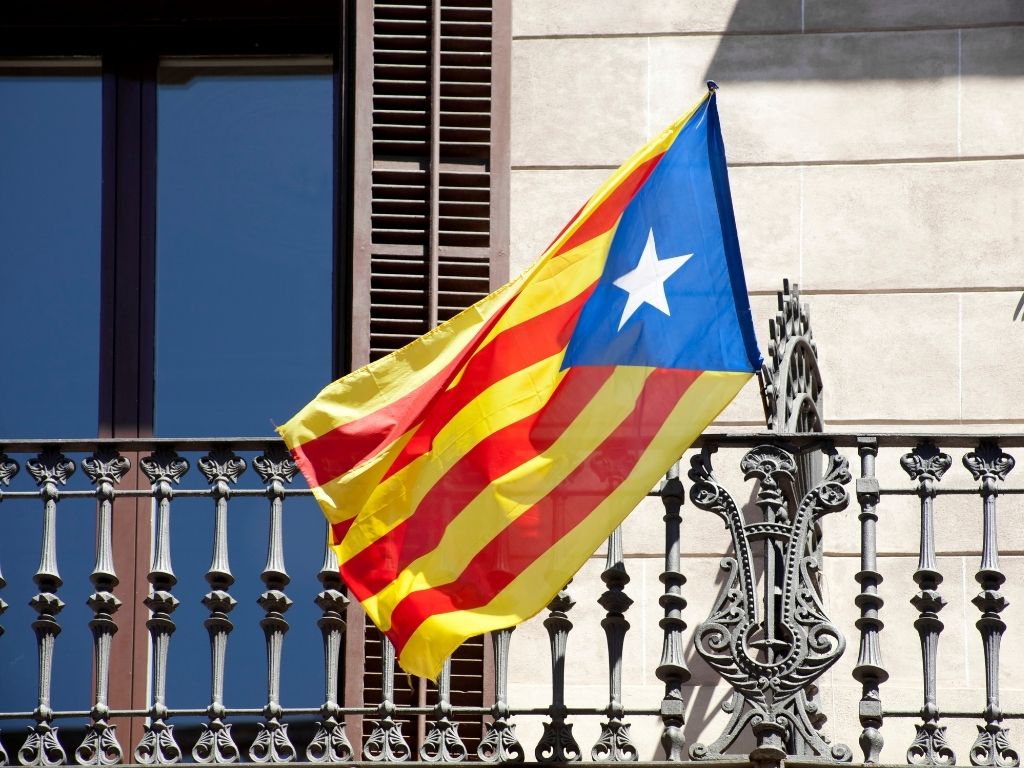
- Catalonia is one of the 17 autonomous communities in Spain and has been designated as its own nationality with a 7 million population spread across 4 provinces, Barcelona, Tarragona, Lleida and Girona, which is also the capital of the Costa Brava Region.
- As an autonomous region with historical importance, Catalonia manages its own taxes, education and healthcare system and we also have our own police, the Mossos d’Esquadra.
- Barcelona is the capital city of Catalonia, and home of La Generalitat de Catalunya, the Catalan government, located in Jaume I Square, in front of the Barcelona City Hall.
- Catalonia has its own flag made of 4 red stripes over a golden background, its own language and traditions, like the fun pooping log at Christmas. You may see a version of the Catalan flag hanging from many balconies across Catalonia that has a blue triangle and a white star on one end. This is the independentist flag of Catalonia.
- Catalan, along with Spanish and Aranese, a dialect of Occitan, are the official languages of Catalonia. Catalan is therefore not a dialect of Spanish, but its own unique language like Italian or Portuguese, all coming from Latin and whose origins predate Spanish.
- The public education system in Catalonia is taught in Catalan and all students learn Spanish. It is not possible to be Catalan and not speak Spanish, everyone in Catalonia is bilingual. If anyone tells you Catalans don’t speak Spanish you can be 100% sure they are lying. Local radio stations, the TV and people in the streets, in stores and in all settings speak both languages and public signs are written in both Catalan and Spanish. If a person speaks to you in Catalan and you only speak Spanish, you can simply ask them to repeat it in Spanish and I am sure they will.
- Although Catalonia is a region of Spain, some well known Spanish traditions are not relevant to Catalans. For example, we don’t dance flamenco in Catalonia, that is a tradition primarily from the south of Spain, and we do not support or even allow bullfighting, this cruel sport was actually banned in Catalonia in 2010, no bullfight has taken place since then (despite the Constitutional Court overturned that ban) and the city’s only bullfighting ring was turned into a shopping mall in 2011 (you can find it near Placa Espanya). While you can find some flamenco schools and high quality “tablaos” in Barcelona, they are not a Catalan tradition.
Fun and interesting facts about Barcelona
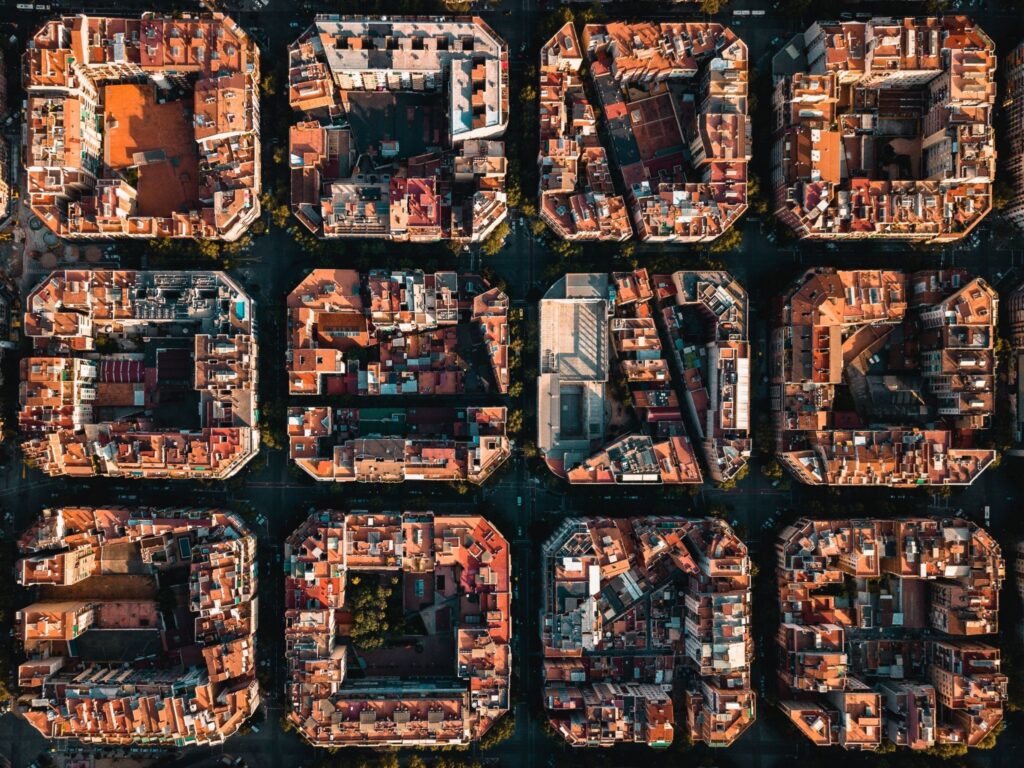
The city of Barcelona is a fascinating place, get to know it better through the below thoughts.
- About half of the 1.5 million population of Barcelona were born elsewhere, that includes 25% in the rest of Spain and 25% abroad. Walking around the city will allow you to hear lots of different languages and see people from all walks of life in what is a peaceful co-existence of religions, cultures, identities and backgrounds.
- Barcelona is a very environmentally conscious city and received the world’s first “Biosphere World Class Destination” certification in 2011, showing its commitment to sustainability in various different categories like transport, accommodation and cuisine. Catalonia was the first region in its entirety to receive this certification in 2015. Catalan people are very environmentally aware and very committed to social responsibility and doing what’s right for the environment.
- Barcelona has been listed as one of the best urban beach cities in the world by publications like Conde Nast and National Geographic and offers something not really found in many other cities in Europe, a long stretch of beach walking distance from the Gothic Quarter.
- Barcelona has been home to many famous artists and personalities, from Antoni Gaudi to Picasso who called the city his true home despite having spent most of his life in exile in France. It was also home for George Orwell who even dedicated a book to the city, Homage to Barcelona, and Hemingway who fought in the Spanish Civil War on the Republican side and defended the Catalan cause.
- Had it not been for the authorities thinking it would be an eye-sore, Barcelona would have been the home of the Eiffel Tower too, but Gustave Eiffel’s design did not gel with the city’s low skyline and the design was rejected before being accepted in Paris.
- There are many fun facts surrounding the city’s most famous architect, Gaudi. He was a genius and a very eccentric person thus the center of many interesting stories. For example, Casa Mila, also known as La Pedrera or “The stone quarry”, was George Lucas’ inspiration for the Stormtroopers outfit in Star Wars and the city council took him to court over construction permits of the building. The epic Sagrada Familia Basilica, his most famous work, remains unfinished and will take longer to complete than the Great Pyramid of Giza in Egypt and the Great Wall of China. While we celebrate it today as an incredible building, George Orwell described it as “one of the most hideous buildings in the world”.
- Ever since Roman times, Barcelona has been an important port. While trade is no longer placing it among the largest ports in the world, the city remains the busiest cruise port in Europe ahead of Venice with more than 3 million passengers.
- Outside the Medieval city center, the adjacent Eixample neighborhood was designed as an innovative grid-system. From above, you can see the unique and globally awarded octagonal blocks designed by Ildefons Cerda in the 19th century and perfectly preserved until today. This design makes it extremely easy for visitors to navigate the city; Each block is 100m long on each side so when you look at a map of Eixample you can always tell the distances by multiplying the blocks by 100m. The corners of each block are round instead of square so you and tram drivers could see oncoming, and so air flowed better. 150 years later, Example remains exactly the same as when it was designed with each block, or island, becoming a unit with internal patios and gardens conceived as social spaces for the neighbors to interact.
- Barcelona is home to Europe’s largest stadium, Camp Nou, the stadium of FC Barcelona. During the years of oppression under Franco’s regime, the stadium was the only public space where Catalan was spoken and which the police never dared to enter and this, among other reasons, is why the club’s motto is “More than just a club”. Barca as it is amicably known, is a symbol of Catalonia, of Catalans and of our identity and it is not just about football. Before the pandemic, the club was also the world’s wealthiest football club with annual revenues of 800 EUR, and the second largest in the world in terms of social media fans, with more followers than the entire NFL league.
- If you like art and history, you will have plenty to choose from because Barcelona is home to 55 museums, from one devoted to chocolate (did you know Barcelona was a major center of chocolate when the bitter product arrived in Europe from Mexico?) to a museum for funeral carriages or the famous Picasso Museum, Miro Museum, National Art Museum of Catalonia where you can find the largest collection of Romanesque art or the more contemporary MNAC, or Contemporary Art Museum among others.
- Barcelona has been a recognized UNESCO City of Literature, this makes perfect sense considering that instead of Valentine’s Day, in Catalonia we celebrate St. George’s Day on the 23rd of April, when we commemorate the legend of St George and the Dragon and all the streets fill with roses and books. Over 7 million roses are sold on that day and book authors can be found on every street corner signing copies of their books.
- Spain was the fourth country to legalize gay marriage in the world in 2005 and there is even an anti-homophobia law that was passed in 2014. Along with its neighboring port city of Sitges, Barcelona is one of the top LBGTQ+ tourist destinations.
- Another progressive stance that the city has taken is the decriminalization of cannabis. This doesn’t mean that it is 100% legal to smoke weed. In order to be able to enjoy a spliff in Barcelona, you need to become a member of a Asociaciones Cannabicas or Cannabis Club. When visiting one of these establishments, you do not “buy” weed, but rather “have”, “get”, “try” or “contribute” to some weed. This means that you are not actually allowed to possess marijuana or even smoke it in public, but become a member and visit one of these clubs. It is a different system than that of Colorado in the US or Amsterdam in the Netherlands.
- Barcelona is one of the best startup hubs in Europe along with London, Berlin, and Amsterdam. If you stroll around the 22@ district you are bound to stumble upon some of the city’s unicorns, from Glovo to TravelPerk to Typeform.
You can read more fun and interesting facts about Barcelona here.
Fun and interesting facts about Costa Brava
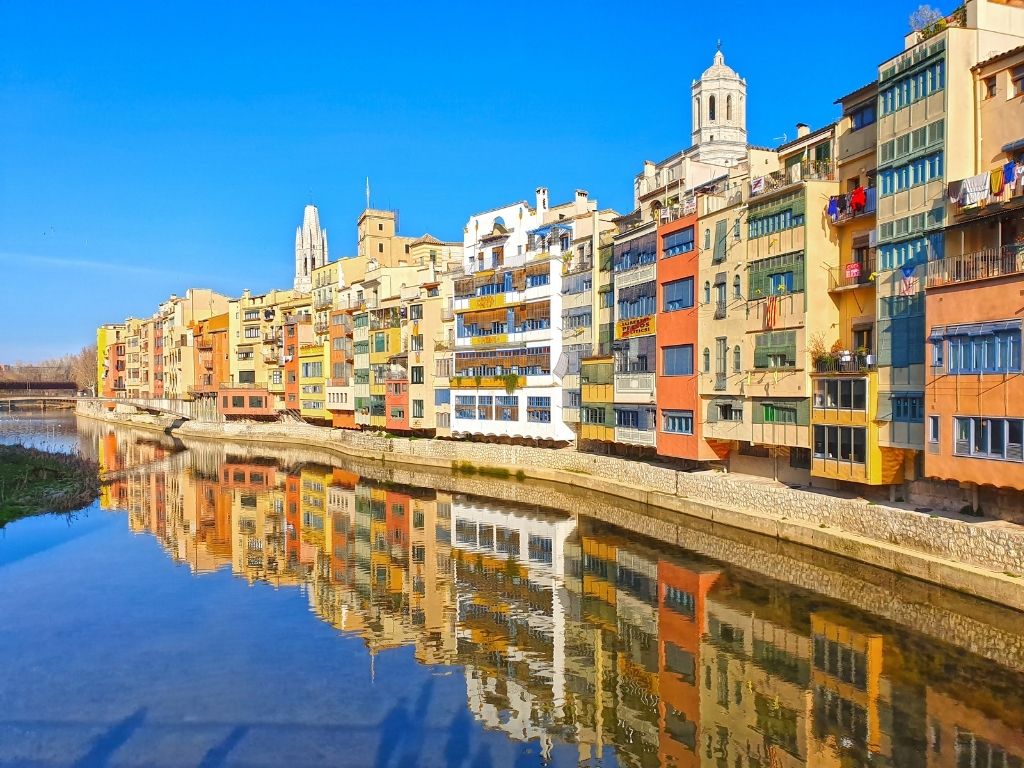
Costa Brava is quite a unique region of Catalonia and so there are a few interesting bits and pieces that will help you learn more about it.
- Costa Brava, or brave coast, is a stretch of coast that runs from the border with France all the way to Blanes and which gets its name from the many cliffs, rugged coastal areas, coves and mountains. Many of the roads, especially closer to France, are narrow winding paths with just one lane so driving can be a bit dizzying.
- The area is of great cultural and heritage importance and has been inhabited since Iberian times in the 7th century BC. Its strategic location on the Mediterranean coast attracted Greek traders who settled in the area of Empuries in the 5th century BC, which later on became the first Roman port city in Spain inhabited until the 3rd century BC when Barcino grew in importance. During our trip to Barcelona and Costa Brava we will be staying at a hotel that once hosted the archeologists who discovered and worked on the preservation of Empuries, located nearby.
- Besides Iberian tribes, Greeks and Romans, Costa Brava developed and expanded during the Middle Ages when many of the well preserved coastal towns were built. Tossa de Mar, Pals or Peratallada are some of the best kept examples of that growth.
- The city of Girona, capital of Costa Brava region and of the province of the same name, was also a Roman settlement founded in the 1st century AD as the beginning of the Via Augusta in the Iberian peninsula but thrived the most in Medieval times, especially after the fall of the Umayyad Caliphate that occupied most of Spain and Catalonia until the 9th century. As a border city between Al-Andalus and the Carolingian Empire, Girona moved sides between Spain and France for decades until the entire Catalonia was unified under Wilfred the Hairy in the 9th century. From then on, Girona and Costa Brava, became a center of power and wealth, first as a Duchal and then a Principality. Today’s Spanish King still holds the title of Prince of Girona. It was in the Middle Ages that Girona enjoyed prosperity and became one of the most important centers of Jewish culture in the Iberian peninsula. With the Spanish Inquisition and expulsion of Jews from the Kingdom of Spain, Girona lost an important community and engine of wealth but the Jewish Quarter remains one of the best preserved in Europe.
- A sleepy town, Girona has just over 100,000 inhabitants and received few international tourists until the launch of low cost flights to its airport, the gateway to Costa Brava, in the late 90s brought in a stream of European visitors attracted first by cheap flights and a quick connection to Barcelona and later on to the city’s newfound stardom as the backdrop to many large Hollywood productions such as Game of Thrones.
- Architecturally, Girona has many fascinating spots. Its Cathedral is a fine example of Gothic architecture and has the largest Gothic nave in Europe, it is impressive to see how such a wide nave can hold up without any columns. Within steps from the cathedral you can visit the Arab baths, a medieval monastery and the complete Jewish Quarter.
- The Costa Brava region is a globally recognised culinary destination and has been home to two of the World’s Best Restaurants in the World, elBulli, three times crowned as number one and El celler de Can Roca, twice winner. They are both located within kilometers of each other along with other Michelin-starred restaurants. This is an incredible feat when you consider that only a few thousand people live in the region.
Barcelona and Costa Brava travel tips
Now that you have a better understanding of Barcelona, Girona and Costa Brava, it’s time to find out all about the practicalities of traveling there.
Passport and visa
- Process your visa in advance. Most travelers from Europe or the US don’t need a visa to enter Spain, however, if you need one, you should start the process a few months in advance as it can require a lot of paperwork and time.
- Schengen zone. Spain is part of the Schengen zone so your visa to the country will also allow you to travel to any other country within the zone including, for example, France, Italy or Germany, but excluding the UK which is not part of Schengen or of the European Union. Your Schengen visa is typically valid for up to 90 days of travel within the zone in a 180 days period.
- Passport validity. Besides the visa, travelers to Spain need to ensure they have a passport that is valid for 6 months after their departure and that has at least 2 empty pages.
- Check out our live session on Travel Documents & Digital Nomad Visas here.
Health and safety
Spain has one of the best healthcare systems in the world and the best part is that it is universal and free for everyone. A network of clinics and hospitals can be found across Barcelona and Girona provinces and you are never too far from help. However, we always recommend to travel prepared with a complete first aid kit.
- Bring all the medication you’ll need. While during your trip to Barcelona and Costa Brava you will never be too far from an urban center, a doctor, a hospital and a pharmacy, it is strongly recommended to bring any prescription medication you may need and enough of it to last you the entire trip. Your specific medication may not exist in Spain, or it may require a prescription you need to see a doctor for, save time and hassle by bringing everything you may need with you.
- Get that coverage. We never leave the house without purchasing extensive medical and travel insurance coverage and this is why we make it mandatory to join our tours. If you are found in a medical emergency, the ambulance will pick you up and the hospital will attend to you first, no questions asked. However, you should make sure that you have adequate medical insurance to cover the expenses. Unexpected accidents do happen, and if you needed to be evacuated back home with an injury, the medical bill could bankrupt you. The best travel insurance will differ for each traveler, depending on the nature, style, and length of your trip, so we recommend using an aggregator and comparison tool such as Travel Insurance Masters to find the right one for you depending on what coverage you want, age, location, trip, etc.
- Passport copies. All hotels are required by law to take a picture of your passport so don’t be alarmed if they do.
- Pickpockets: Con artists and scam experts operate around the most popular and touristy areas of Barcelona and you should alway keep an eye on your belongings, never flash jewelry or cash and keep your phone stored away and your cross-body bag zipped when in areas such as La Rambla, Placa Catalunya or in the metro. Sadly, stolen wallets and phones are a real nuisance and if you don’t pay attention you can be sure your valuables will disappear. On the other hand, this always happens in a non confrontational or violent way, your wallet will be simply gone if you leave your bag unattended or your phone on your table while having a drink at a terrace. To avoid this, always zip your handbag and carry it across your body and in front of you. When I walk in crowded spots, I put my hand over the zipper and I never ever hang my handbag at the back of my chair when at a bar or restaurant, put the phone down on the table or walk around with an open bag or my wallet in my back pocket. If you just pay attention to these things, you will be totally safe.
Essentials
Here are some essential travel tips to consider.
- Stay connected if you must. We will be within telecommunications signal for the duration of our trip and you can easily buy a local SIM card at the airport or in the shops in Barcelona upon your arrival. If you intend to do so, make sure that your phone is unlocked and will work with a foreign SIM card. This may mean having to go to the local store in your country before your departure. If you buy a local SIM card, make sure that the store attendant can change any settings required for the SIM to work with your phone before leaving the shop.
- Only EUR will be accepted. Spain uses the EURO and no other currency is accepted in the country. You can exchange your money into EUR before leaving your country, exchange them at the airport or any of the currency exchange shops in the city or withdraw EUR directly from the local ATMs. With COVID, almost all the shops in Spain now accept credit card payments regardless of amount and you can easily get by without any cash. I recently spent 5 months in Spain and used less than 100 EUR in cash, everything else I paid by card.
- Bring a plug adaptor. Spain uses the two-prong round pin plug like most of Central Europe so bring a universal adaptor.
- Download useful travel apps to help you have offline maps, safety emergency calls, things to do, where to eat, and more!
- Two kisses. Everyone in Spain greets everyone with two kisses one on each cheek. If you just met someone, you will kiss them when being introduced. I kiss everyone I just met except for people I meet in formal work environments, although even there, I would most likely kiss them too unless they are a potential client or supplier rather than a colleague or a friend’s friend and it is a very formal atmosphere or they are not Spanish.
Local culture and customs
I have told you quite a lot about Catalan traditions and customs but here are a few more things to consider.
- Lunch breaks. In Spain, most businesses close at lunch time for an extended period so employees can go back home, prepare and eat lunch and maybe even have a short nap before returning to work. While this is not the case anymore in Barcelona, where most stores and offices just break for an hour, outside of the city it is common to find stores closed from 1pm to 2pm until 4pm or 5pm.
- Learn some basic Spanish or Catalan. English is widely spoken in the city, especially in businesses that are used to seeing tourists, however, a few basic words will get you far and win the sympathy of locals and will be easier to meet people and make friends while traveling. Questions such as where is the bathroom? (¿Dónde está el baño? In Spanish or On es el bany? In Catalan) or how much is it? (¿Cuánto cuesta? In Spanish or Quant es? In Catalan) can be useful phrases. Especially in smaller towns, it is polite to say good morning (Buenos dias in Spanish or Bon dia in Catalan) or hello (hola) and goodbye (Adios in Spanish and Adeu in Catalan) when you enter a store, especially at places locals visit often such as bakeries, local bars, market stalls, pharmacies, newspaper kiosks, etc. Use interactive language apps to learn the basics before your trip.
- Bilingual nation. As mentioned above, everyone in Catalonia speaks both Spanish and Catalan natively, however, if their mother tongue is Catalan they will speak to you in Catalan. From a simple hello, you can’t tell if someone is speaking Catalan or Spanish so if you speak Spanish and want to practice, you can simply tell someone you don’t speak Catalan and everyone will switch to Spanish for you.
- Directness. If you learned Spanish in Latin America, you may find Spanish people rude. This is because the way we speak is very direct and instead of saying “can I have” we simply say “I want”. It is not rude to tell a waiter that you want to eat a steak with fries, maybe you add a please at the end of your sentence but you will certainly not ask if you “may please have a steak”. Intonation is what conveys the please / thank you in Spain and Catalonia is no exception. If you walk into a bar and ask for a coffee, you may simply say “Un cafe solo, por favor”, “a coffee please”. Likewise, waiters may not smile all the time and if they are busy, will get down to business and may appear to be rude. This is just how we are culturally and you should not take offence to that. Understand that’s how Spanish people interact and interpret it accordingly.
Tipping
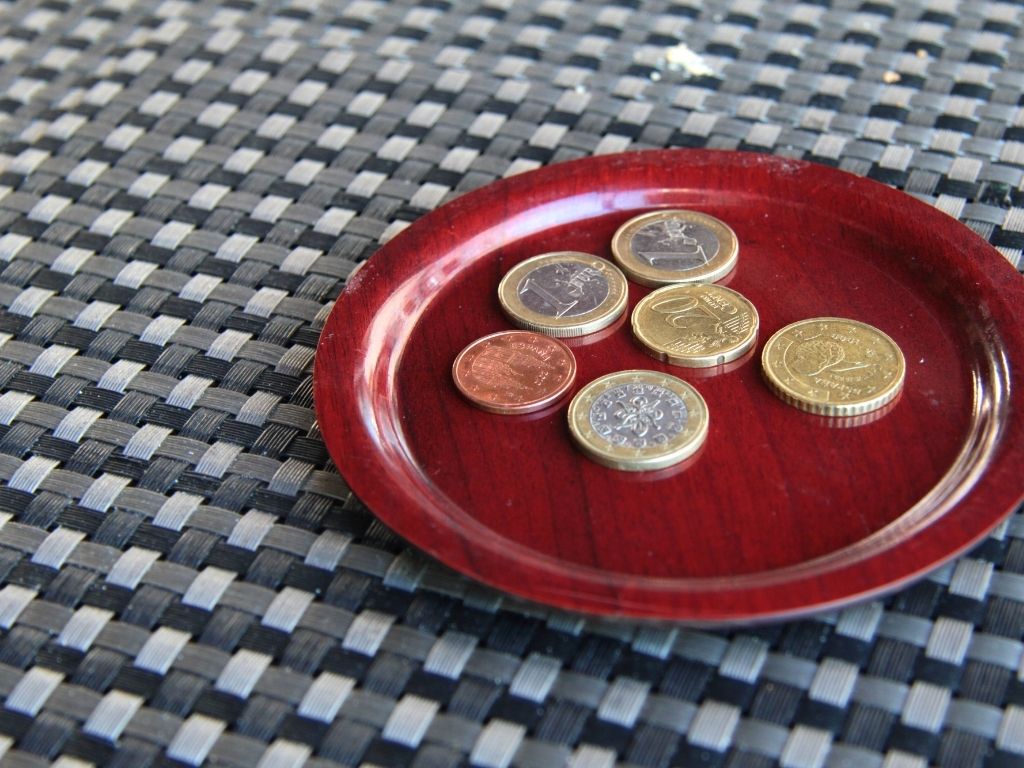
In Spain, we don’t have a tipping culture. That means a tip will be appreciated but nobody in the hospitality industry works for tips, staff are paid full time salaries for their jobs and tips are an extra that would be used to reward exceptional service or when someone did something that is not in their job description.
The only environment where, with my parents and friends, we have always left a 10% tip is at a fine dining restaurant, where it is expected, but this is probably the only situation and nobody will run after you if you don’t. Make sure to bring cash, credit card payment machines don’t have the option to add anything to the bill like in other countries.
In other settings, you may round up bills at restaurants or bars to the nearest numeral (eg. if the bill is 23 EUR you may leave 24 EUR) by leaving the coins you got in change, and may do the same in a taxi.
If you have been on a tour and thought the guide did an exceptional job, you may also want to leave him or her a tip, but know that prices for a tour already include a full salary and that staff does not rely on tips. The exception would be the case of free tours which are designed to be a tipping-only environment where you give what you thought was fair.
In hotels or other settings where someone does something for you, one EUR is plenty of tip. For example, to the room service person or the staff who may carry your suitcase or the housekeeping team. Know that Spanish people would rarely tip anyone unless the person went above and beyond their duty.
The philosophy is: people get paid a fair wage and tips are to reward exceptional behavior so with that in mind, you should use them to say thank you to someone who made your experience extra special. Of course, a tip will always be appreciated, but it will not be expected.
Local cuisine
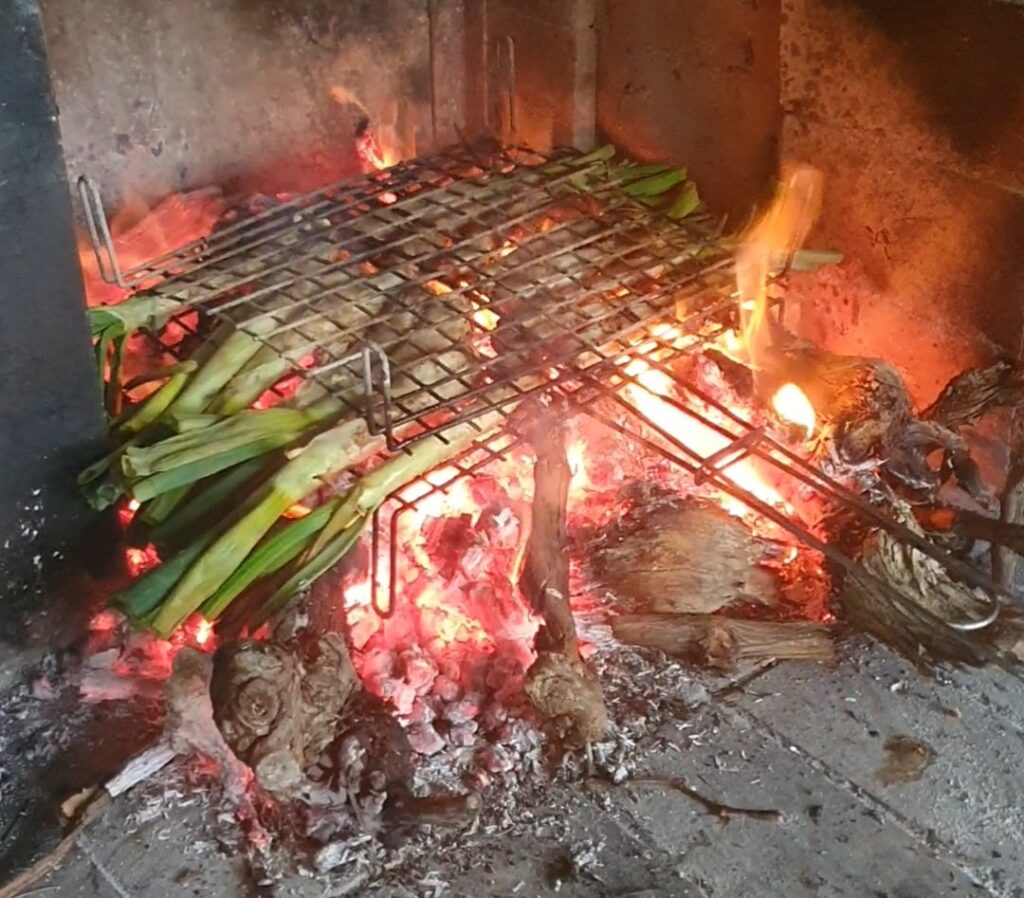
Barcelona is a well known culinary destination with over 30 Michelin stars and many awarded and world renowned chefs with restaurants in the city. You can find everything, from street food in the markets to set lunch menus for 15 EUR with wine, starter, main and dessert to fusion restaurants to fine dining and avant garde cuisine that has revolutionized the world.
What’s more, you won’t need to get a loan to enjoy dinner in some of the best restaurants in the world because even the most expensive and awarded restaurant of all, Lasarte’s 3-Michelin star restaurant of the same name, will set you back less than 200 EUR per person for a set fine dining degustation dinner. If you’re traveling solo don’t be afraid of eating alone, all restaurants will make you feel welcome.
Spanish cuisine is very diverse and each region has its own specific dishes, Catalonia is no exception.
As a region that has always been on the border between the Iberian Peninsula and continental Europe, and at the crossroads of so many civilisations and conquests, Catalan gastronomy has evolved to include lots of influences drawn from the land and its rich volcanic soil as well as from the international trade that has always been in the blood of every Catalan.
Catalan cuisine is the epitome of the Mediterranean diet and relies on olive oil, seasonal vegetables (tomatoes, aubergines, peppers, lettuce, cauliflower, cabbage, carrots, onions, garlic) and fruits (apples, pears, peaches, apricots, watermelons, melons, lemons, oranges, mandarins, figs, cherries, strawberries), legumes and cereals (chickpeas, peas, wheat based products, beans), free range meat from the green pastures of the lower Pyrenees and the volcanic soils of La Garrotxa (beef, pork, lamb, chicken) and seafood from its long coast.
In Catalonia we only eat what’s in season and practically everything you can find in restaurant menus and on the supermarket shelves is what grows within 100km from where it’s eaten.
The cuisine changes throughout the year with the weather and the availability of produce from fresh, light and raw dishes in the summer months to soups and stews in the winter.
Km0 and Proximity food movement is strong in Catalonia and thanks to our deep rooted agricultural past and love for tradition and for what is ours and hand crafted, our cuisine has always relied on what is fresh, local and in season.
Here are some of the best dishes, though beware that many may not be in season when you visit:
- Cured meats. In Spain, and in Catalonia, we eat a lot of cured pork meat. Besides the world famous Iberian ham, which comes from Andalusia, in catalonia we also have locally specific cured meats such as fuet (long and thin air cured meat sausage), llonganissa (a thicker version of fuet) or butifarra which is a cooked pork sausage. These can be eaten as the filling in a sandwich, served in slices as a tapa or eaten as a main dish on a large slice of toasted tomato bread.
- Tapas. Not a Catalan dish per se (tapas are thought to have originated in Andalusia and can be found everywhere in Spain) but a very common shared meal style that is enjoyed across Catalonia. Tapas are plated portions of food served to share family-style among the table. They can include anything because the word tapa does not define the food but rather the eating style. Tapas can be made of cold cuts and meats such as ham, omelet portions, salads, fried calamari, etc.
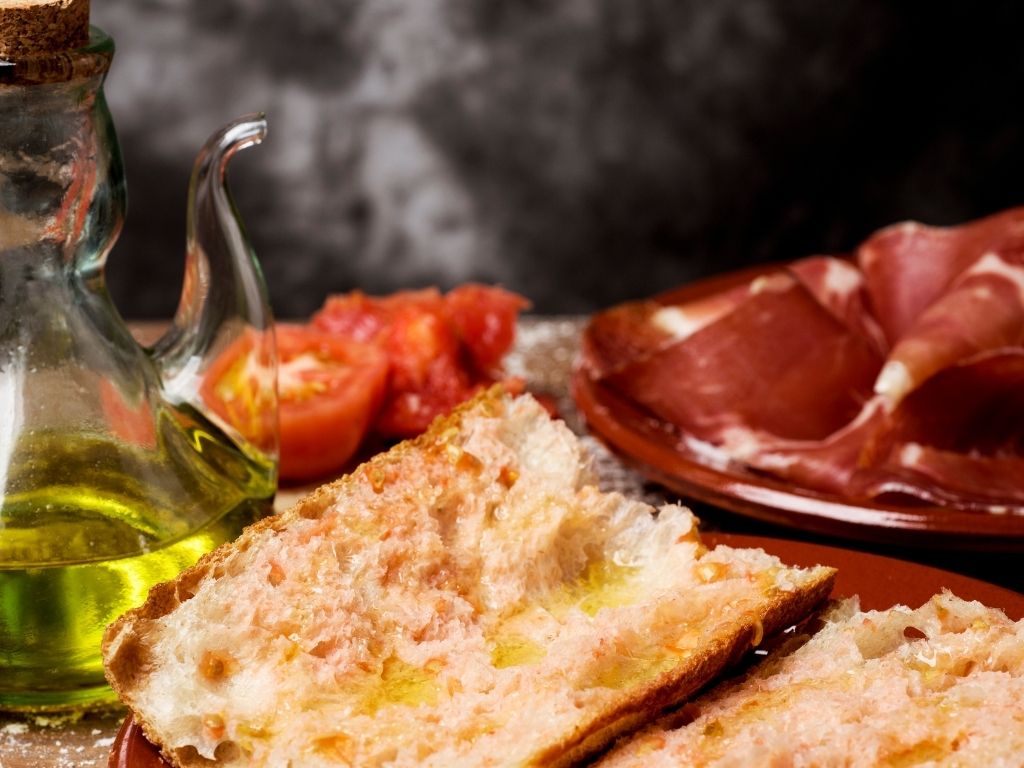
- Pa amb tomaquet. Perhaps the most famous Catalan dish is the humble bread with tomato, eaten across Spain but originating in Catalonia. This is often served as the basis for sandwiches, for tapas or as a side dish and it consists of slices of bread smeared with a specific type of tomato (hanging tomato) that is very soft and sweet and can be rubbed against the bread. Top it with a generous splash of extra virgin olive oil and some salt and you have an absolutely delicious combination. The dish can sometimes be served as its separate ingredients, so you make your own, or on “crystal bread” which is thin and extra crunchy, on large farmer’s bread or on baguette.
- Open fire barbecue. Catalonia, like the rest of Spain, is eminently agricultural and once you leave the city behind you can find large expanses of agricultural land that grow anything seasonal for consumption within the area. One of the best meats you can find in Catalonia is beef, pork and lamb and we like to enjoy them rustic style on an open fire barbecue where wood (not charcoal) is used to grill the meat and vegetables on top. On a typical Catalan barbecue you will also find artichokes (if in season), grilled potatoes (cooked in aluminium tin foil) and all sorts of meat cuts, from lamb chops to chicken legs or pork sausages.
- Canelons. Cannelloni are a very very traditional Catalan dish eaten on special occasions and on the weekends as they take a lot of effort to make from scratch (if made the traditional way). Traditional Catalan cannelloni are filled with roast meat in its gravy (so you first need to roast it) and covered in bechamel sauce and cheese then oven baked until brown and they are delicious. There are two days a year when cannelloni are specially eaten: St. Joseph (19th March) and Boxing Day /St. Steven’s (26th of December).
- Sausage and white beans. A grilled pork sausage served with a side of baked white beans usually cooked in parsley and garlic is a very simple but quite traditional Catalan dish eaten year round.
- Duck with pears. Another traditional catalan dish that takes quite some time to make is duck cooked with pears in the oven, slowly. Duck can also be served with pine nuts and prunes or cooked in other ways and is a very common poultry dish in Catalonia. For example, at home, we eat fuck with orange, pine nuts and prunes on Christmas day.
- Calcots. This long onion that looks like a leek is eaten only in February and March when it is in season and it is an experience in itself. The vegetable is cooked until charred on the outside on an open fire and then the outer black layers are peeled to reveal a soft and melt in your mouth inner sweet onion that you need to dip in a special almond and tomato sauce. It is divine and messy but oh so good!
- Grilled fish. If you eat near the sea, you are bound to find lots of seafood and fish dishes that simply grill the produce in olive oil, parsley and garlic and accompanied with salad, grilled potatoes or grilled vegetables. This can include calamari, squid, any kind of white fish (dory, seabass, monkfish, etc.), or prawns, and it is a very healthy way to eat fresh seafood.
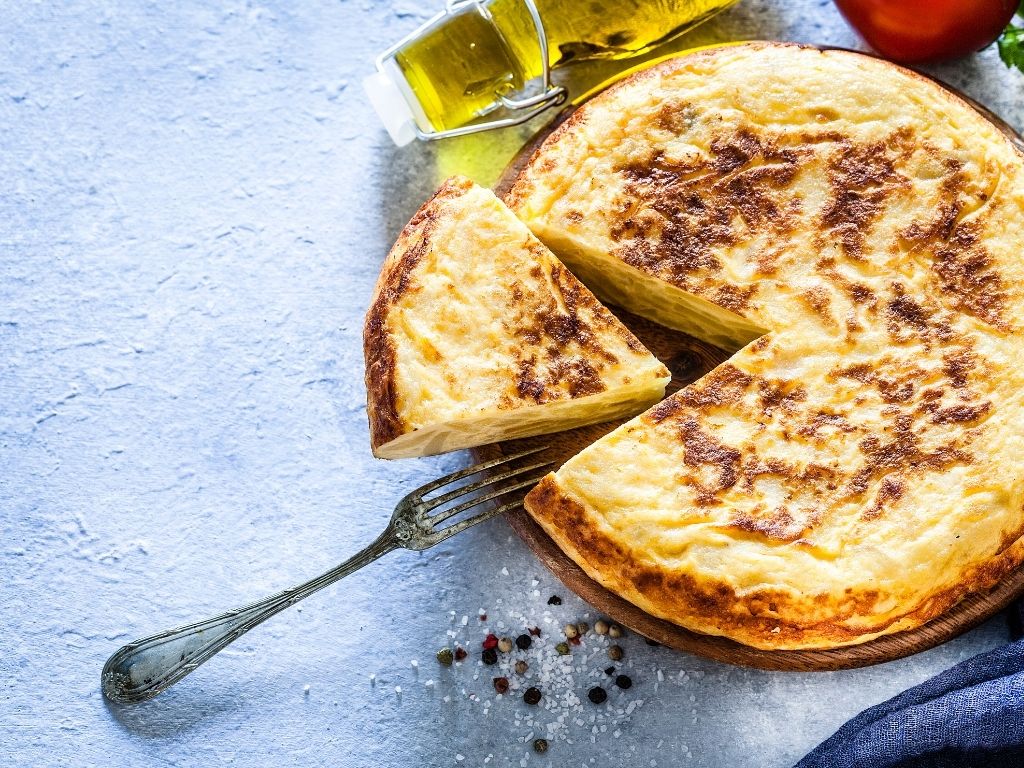
- Potato omelet. While not just typical of Catalonia, potato omelet is about the most omnipresent of all the tapas. You can find it at breakfast, lunch or dinner, as a snack or in a sandwich. This simple dish is made with slowly cooked potatoes and sliced onions covered in beaten egg and then cooked in a pan. Your omelet slice will usually be served with bread with tomato.
- Escalivada. One of the simplest and most delicious dishes and one that I have always cooked even when living abroad. Escalivada is just roasted peppers, aubergines and sometimes onions cooked slowly either on an open fire or in the oven, drizzled in olive oil. You then peel the vegetables and lay them on a tray. You can eat escalivada as a starter, as a tapa, on toast, as a side dish, etc.
- Esqueixada. A cold salted codfish salad that is particularly eaten during Carnival and in the summer months because it is light, fresh and healthy. Salted codfish is first desalted by soaking it in water for a day and then served on a base of curly lettuce with canned tuna, anchovies, olives, tomato and sometimes pieces of other vegetables such as peppers. The salad is served with xato sauce which is very similar to the sauce eaten with calcots.
- Black rice: a kind of seafood paella cooked in the same pan and listed under the paella section on most menus, but cooked with squid ink so the rice becomes completely black. You will usually find squid and calamari as well as prawns in it. The dish is always served with aioli.
- Fideua: Another paella-like dish that is made exactly like it but with short noodles (fideus) instead of rice. Fideua is typically seafood based and cooked with a fish broth and served with aioli.
- Fricando: a stew made with veal or pork and cooked slowly in a tomato and onion based gravy with wild mushrooms.
- Cargols a la llauna (Snails): Yep, in Catalonia we also eat snails but we cook them in a metal tray and on the open fire, although they can also be cooked in the oven, and with a generous amount of garlic, olive oil and parsley.
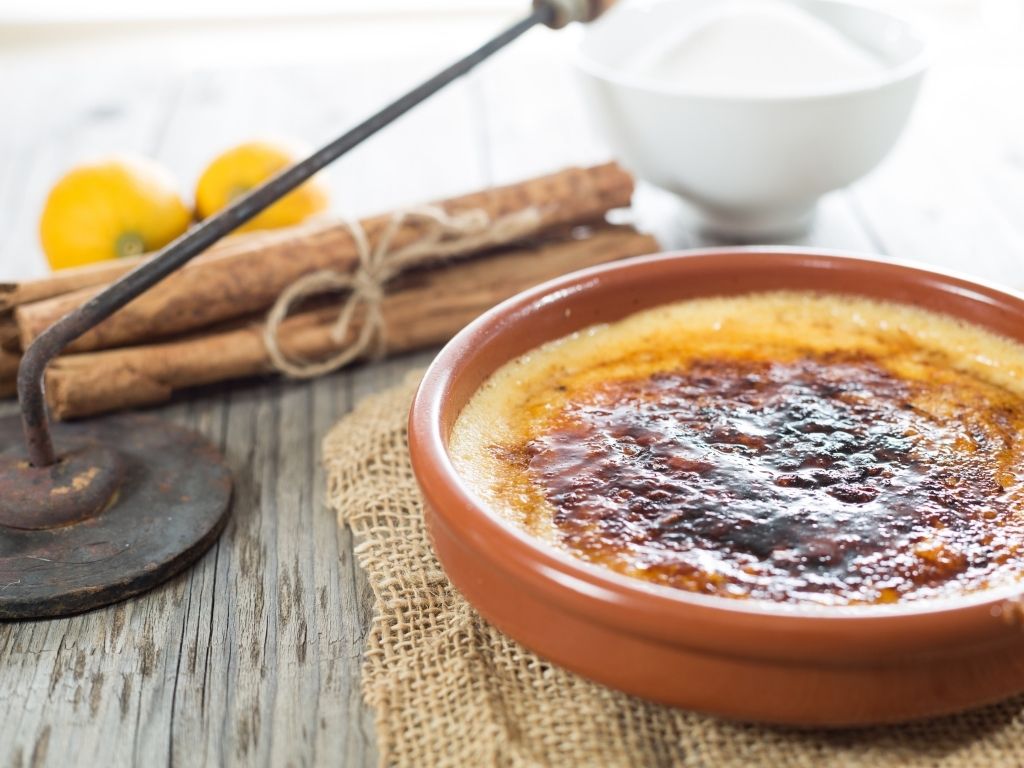
- Crema catalana: This is the most famous, popular and loved Catalan dessert and it’s basically an egg custand very much like the French creme caramel, essentially made with eggs, lemon rind, cinnamon and milk and with a thin crust of burned sugar on top. Homemade crema catalana is a holiday dish that is usually enjoyed on special celebrations though nowadays it is also sold in the dairy section in supermarkets and commonly offered at restaurants.
- Pastries and sweets: Catalans have a very sweet tooth and you can just walk into any bakery to find out the huge array of sweets, pastries, bread and desserts that we enjoy. Plus, there are seasonal sweets made for specific occasions such as Lent, Carnival, St. Joseph, Christmas, Easter, etc.
Besides the food, it’s important to note that in Spain we eat very late. That means restaurants do not open before 1pm, sometimes even 1,30pm, for lunch and then will not open until 8,30pm or 9pm for dinner.
In Barcelona, this is easier to manage because there are many restaurants that are open all day for tourists and visitors who like to eat earlier. Otherwise, your best bet to get food outside the regular meal times is to go to a bakery and get a sandwich.
Music and bands from Barcelona
Barcelona and Catalonia have a thriving music scene and there are lots of bands, especially pop and rock ones, who sing in Catalan. Additionally, many renowned music festivals such as Primavera Sound or Sonar are held in the city, especially during the summer months.
Because of the dictatorship, Catalan bands are a recent phenomenon since the language was banned in public during Franco’s regime, but as soon as democracy returned, so did Catalan culture in all shapes and forms and experienced ina real revival in the late 70s, 80s and 90s.
Besides rock and pop, there are also lots of singer-songwriters and a specific music style that is typical of Catalonia, La Rumba Catalana, a mix of flamenco and Cuban music. Rumba catalana originated in the Spanish gypsies migrating to Catalonia from the south of Spain and mixing with the Cuban influences of returning Americanos (Catalans who migrated to Cuba in search of prosperity when it was a Spanish colony and returned with their wealth).
Some of the most well known and established Catalan bands you could check out are as follows:
- Joan Manuel Serrat and Lluis Llach: The two most famous Catalan singer-songwriters of the dictatorship, they were forced to sing in Spanish for many years but eventually transitioned to Catalan even before the end of the regime. Today in their 70s, they still occasionally sing some of their famous songs which were often an expression of Catalonia’s identity and culture when it could not be shared in public.
- Els pets (the farts) is one of the founders of the Catalan rock movement. At the time when they were famous, Catalonia was experiencing a cultural revival which prompted the creation of a lot of new bands though they are the only ones still around. Other famous bands of the time and co-founders of the movement are were Lax’n’busto (famous because their first hit was a song that got banned because it criticized their high school teacher who took them to court), Sopa de Cabra (goat soup), Sangtrait and Sau.
- Sopa de cabra: Another of the founders of the Catalan rock / pop movement that reformed as a band in 2015 after years without playing.
- Sau: Named after a small village and the place where the Catalan Constitution was signed, Sau was perhaps the most beloved of all the Catalan rock bands of the 80s and 90s. The band dissolved in 1999 when the singer died after a concert in Vilafranca del Penedes at the peak of their career but for many Catalans, their most famous song, Boig per tu (Crazy for you) remains a hymn of Catalonia. My sister chose it as the song for the first dance at their wedding
- Companyia Electrica Dharma: One of the oldest Catalan bands started before Franco died, in 1972. With the advent of democracy, they were there and ready to front a movement that celebrated all of Catalonia’s heritage and blended rock and pop with folkloric sounds. In 2022, CED turns 50 years old and celebrates the occasion with a huge concert before St. George’s Day.
Books about or set in Barcelona and the Costa Brava
Barcelona and Catalonia have been the stage for many books both historical and fictional. Below is a selection of books that will not only give you a favor for the culture but also for the city through the eyes of locals and visitors.
- The Shadow of the Wind, Carlos Ruiz Zafon: The novelist’s first successful novel, like the following ones in the book series, were all set in the city. Through the stories in this international best seller you can learn more about the city at the end of the 19th and beginning of the 20th century.
- Barcelona, Robert Hughes: A detail account of life in Barcelona in the peak of its cultural rediscovery, when the city boomed and was a center of art, culture and political discovery, between the end of the 19th century and the beginning of the 20th century, as told by an Australian journalist who moved to the city in the 1960s. A fantastic book for those who want to understand modern day Catalonia through its rich past.
- Homage to Catalonia, George Orwell: A tale of the Spanish Civil War through the eyes of Orwell explains the city’s fighting against the Fascist front and the many atrocities and betrayals committed. Interesting to see how much he despised what is today the city’s most emblematic building, Sagrada Familia.
- The city of marvels, Eduardo Mendoza: A novel that transports you to the period between the two World Expos (1888 and 1929) during which Barcelona was a hotbed of artistic and political discourse and anarchism aimed to counter the growing bourgeoisie.
- Pepe Carvalho detective series, Manuel Vazquez Montalban: A contemporary detective series with Pepe Carvalho at the front that shows day to day life of ordinary people in Barcelona through the cases being resolved.
- Cathedral of the sea, Ildefonso Falcones; Set in the Middle Ages against the backdrop of the construction of Santa Maria del mar Cathedral, this novel relates a story of love and survival at the time of the Spanish Inquisition and is a great insight into the last golden decades of Catalonia before it sunk into a dark period following the War of Succession.
- The time of doves (In Diamond Square in UK), Mercè Rodoreda: This novel whose English title changes depending on the country, relates the story of Natalia’s life, a regular woman who meets a man at a party in Diamond Square, in the Gracia district of Barcelona, and then marries him in the Catalonia of the 1930s. The Civil War arrives and the husband sets off to fight on the Republican side but gets killed. Misery, poverty and starvation surround Natalia and her children’s life and she finally remarries. Rodoreda is one of the few writers of the dictatorships who continued to write in Catalan while in exile, recounting life in Catalonia in what is one of the darkest times in recent history, that of the war and subsequent dictatorship. This is a reference book all children must read while in school.
- The Lonely Hearts Club by Raúl Núñ: A comedic story about finding love that portrays Barcelona’s underbelly, nightlife and darkest secrets.
- Ferran, Colman Andrews: Catalonia is today a globally recognized culinary destination and the birthplace of two of the best restaurants in the world, one of which can be credited with being one of the forefathers of molecular cuisine, Ferran Adria. elBulli, his former restaurant, now a foundation, was chosen the best restaurant in the world several times before closing down at its peak. In this biography, Colman explores the genius and his art.
- Origin, Dan Brown: Part of the trilogy led by symbology professor Langdon, Origin continues in the saga of world changing discoveries and centuries old secrets hidden behind symbols and passwords, in this case, starting off in Bilbao and continuing in Barcelona. While not necessarily a book about the city, this is a unique way to learn more about it through the eyes of a mystery book.
Movies about or set in Barcelona and the Costa Brava
The area around Barcelona and the Costa Brava has been the set of many movies thanks to a thriving production scene.
- Vicky Christina Barcelona: Woody Allen quite likes Barcelona and this movie, a classic from his repertoire, happens entirely in the city and features Javier Dardem and Scarlett Johansson.
- Todo sobre mi madre (All about my mother): Almodovar is one of Spain’s most famous directors and each one of his movies is a hit. Always walking the fine line between the acceptable and the forbidden, contradictions and conviction, this movie, often referred to as one of his best, is no exception. Almodovar explores the life of a transsexual prostitute whose life blends with that of a nun.
- The passenger: This movie was set before Barcelona turned itself to the sea and recovered its light, just around the time of Franco’s death so it offers a unique opportunity to see what the city was like before the makeover that came with the Olympics.
- What about love: 2022 romantic movie directed by Klaus Menzel, featuring Sharon Stone, Andy García and José Coronado, and shot in Costa Brava, including Tossa de Mar, where a love story develops as the main characters shot a documentary on love.
- L’auberge espagnole (The Spanish apartment): A movie about students sharing a flat on their Erasmus and discovering life and the city through a multicultural lens.
- Barcelona: This movie set in the 1980s at a time when Americans were not seen in the best light in Spain, showcases the city through the eyes of two American young cousins trying to have the best time.
- Pandora and the Flying Dutchman: A 1950s film with Ava Gardner shot in Tossa de mar including the walled area of the village and the church of Sant Vicenç and showcasing the legend of the flying Dutchman.
- Suddenly, Last Summer: Elizabeth Taylor descended on Sant Pol beach and the Costa Brava to shoot this Hollywood production and rather unusual movie for the time by Joseph Mankiewicz. The last scene was actually shot in the medieval town of Begur.
- Black bread: The first Catalan language movie to participate in the Oscars relates the life of post-war Catalonia through the eyes of a rural family who live and take care of the country house of a rich family. The contradictions and hardships of that dark period in Catalonia are explained through the daily life of the characters, from forbidden love affairs between Republican children and Civil Guard policemen to arranged marriages, maimed children who played with grenades and spiteful politicians looking for revenge against those who fought on the losing side.
Shows and documentaries set in Barcelona
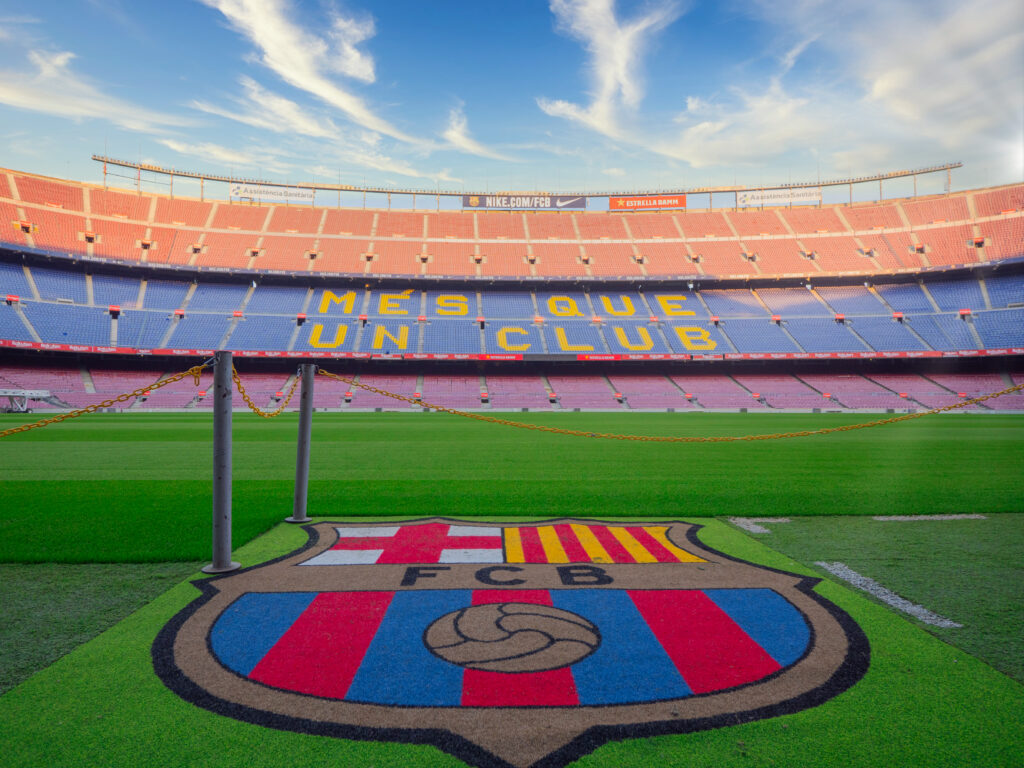
Thanks to Netflix, Catalonia and Barcelona are enjoying the spotlight. Below are some of the most prominent Netflix shows or productions that will give you a glimpse into the region.
- Game of Thrones: This fantastic and epic show has many famous scenes set in Girona, if you are an avid fan, you will recognize the cathedral’s facade and the Jewish Quarter streets.
- Merlí, sapere aude: This original production of the Catalan public TV station Tv3 under the name Merli was later purchased by Movistar and aired across Spain and Latin America in the original Catalan language, albeit a couple of characters speak in Spanish in the series, a fact of life in Barcelona and Catalonia. Netflix recognized the potential of the story and produced the spin off Merlí, sapere aude with English subtitles and with the University of Barcelona medieval Philosophy Faculty building as the backdrop. Set in the heart of the city and showcasing university life, Merlí is an incredibly realistic story showcasing day to day student life in Barcelona, exactly how I experienced it. Sexual discovery, open-mindedness, art, philosophical questions, the struggle between the lower middle class and the wealthy, immigrants and students from the countryside, single parents, the welfare system, and more, all surrounding stories of falling in love and discovering adulthood.
- Cathedral of the sea: Ildefonso Falcones’ book has been turned into a show available on Netflix. The book is really thick so a show might be a more palatable way to enjoy the story.
- Welcome to the family: A drama series where two women are forced to hide the death of a man who is their father and husband respectively when they find out he removed them from his will. Fun fact: One of the actors (Iván Massagué) is my dad’s neighbor and his dog is always at my dad’s.
- Hache: Named after the letter “h”, this show follows a prostitute who falls for a cartel leader in 1960s Barcelona when the right side of La Rambla was synonymous with drugs, prostitution and violence.
- Dos Cataluñas: You can’t visit Barcelona in the 21st century without learning more about the Catalan independence movement and this Netflix documentary shows both sides of the story through interviews with political commentators and some of the movement’s most prominent actors such as Catalan president Puigdemon, prosecuted after the 2017 independent vote.
- Barca dreams: Another key element of Catalonia’s identity, understanding how important FC Barcelona is and in what context it matters to Catalans is a great way to put what may be seen as just a sports team to foreigners, into perspective.
- These Death-Defying Human Towers Build on Catalan Tradition: This short film showcase by National Geographic is a very emotional mini documentary of the human towers (castells) that we build in Catalonia and which are listed as a UNESCO World Heritage site. I grew up one of the most famous towns for this sport and it still brings tears to my eyes when I see a full square packed to the brim and a tower topped by the small kids.

